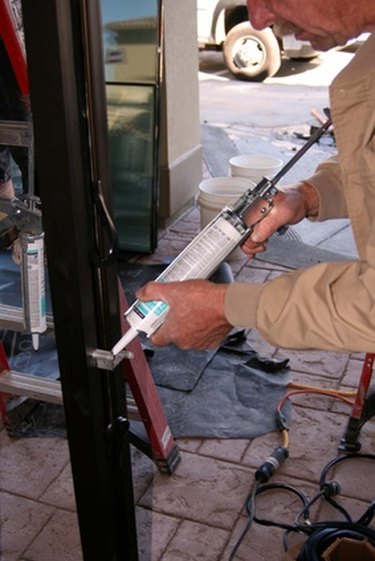Things You'll Need
Soap
Water
Bucket
Scrub brush
Putty knife
Chemical respirator mask
Caulking
Caulk gun

Many commercial caulks adhere well to metal surfaces. Polyurethane caulk works well on small or large gaps, has excellent expansion and contraction capabilities and is chemically resistant. It also requires a respirator and, if used indoors, demands a fresh air hose mask. Silicone caulk made for metal offers ease of application, permanent flexibility and durability to freezing and heat; it works well to effectively seal smaller gaps. Choose the caulking type that meets your job needs, and follow the manufacturer's safety instructions.
Step 1
Prepare the surface of the metal by cleaning away all dirt, grease, oil and debris with warm soapy water and a scrub brush. Scrape out any existing coatings with a putty knife.
Video of the Day
Step 2
Examine the width of the gap you need to seal. Most small gaps up to 1/4 inch may use a 100 percent silicone caulking for metal, such as GE Silicone II Aluminum & Metal. Larger gaps should use a polyurethane caulk, such as SeamStitch Polyurethane Elastomeric Caulk.
Step 3
Ventilate the area when working indoors. Wear an approved chemical respirator mask if using polyurethane caulking.
Step 4
Load the caulk cartridge into a caulk gun by pulling the plunger back and placing the rear end of the cartridge inside the gun. Press the plunger on the gun so it contracts with the bottom of the cartridge.
Step 5
Dry the surface area before applying caulk. Cut a 45-degree slit in the tube top. For smaller gaps, cut closer to the tip for a thinner bead application; for larger, cut farther down the tip. Open the seal on the cartridge by inserting a nail into the tip opening.
Step 6
Position the tip of the caulk at the top of the seam. Depress the caulk gun lever and slowly move down the area to seal the gap. Move evenly and methodically when applying.
Step 7
Cut off the caulk flow when you reach the end of the seam by pushing the nozzle into the seam end, twisting and removing it from the area.
Step 8
Examine the gap to ensure it is completely filled. Larger gaps may need a second layer applied next to the first to fully close the gap.
Step 9
Smooth latex caulk with a dampened finger if desired. Do not overwork the area; this sometimes causes cracking.
Tip
Look for 100 percent silicone caulk designed for metal. Some dry in as little as three hours.
Butyl rubber sealant is also available for metal; use of a respirator mask is also required during application.
Warning
Polyurethane Elastomeric caulk is solvent-based and should be kept from heat, open flames and sparks.
Video of the Day